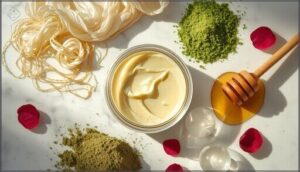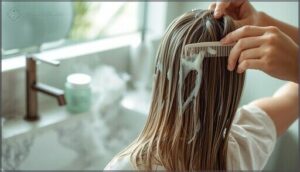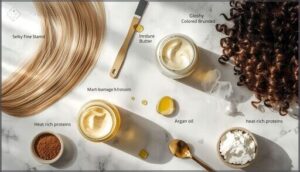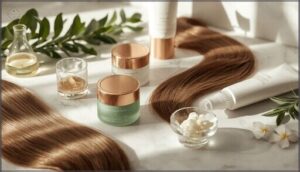This site is supported by our readers. We may earn a commission, at no cost to you, if you purchase through links.
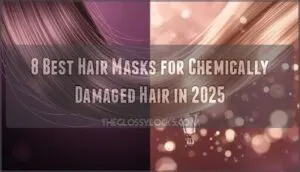 Chemical treatments promise transformation—sleek, straight hair, vibrant color, permanent waves—but they also break down the protein bonds that give your strands their strength. That’s why your hair feels like straw after bleaching, or why those gorgeous highlights come with a side of breakage.
Chemical treatments promise transformation—sleek, straight hair, vibrant color, permanent waves—but they also break down the protein bonds that give your strands their strength. That’s why your hair feels like straw after bleaching, or why those gorgeous highlights come with a side of breakage.
The damage happens at a molecular level, where disulfide bonds snap apart and the cuticle layer lifts away from the shaft. Hair masks designed for chemically damaged hair work differently than your average conditioner. They penetrate deeper into the cortex, delivering concentrated proteins, lipids, and hydrating agents that actually rebuild what was lost.
Here are eight masks that target the specific structural damage caused by color, relaxers, perms, and bleach.
Table Of Contents
Key Takeaways
- Chemical treatments break disulfide bonds and lift the cuticle at the molecular level, causing structural damage that requires deep-penetrating masks with concentrated proteins, lipids, and hydrators—not just surface conditioners.
- Effective repair masks use specific technologies like K18’s patented peptide (reconnecting keratin chains to restore 91% strength), hyaluronic acid (holding 1,000x its weight in water), and bio-restorative complexes that rebuild from the cortex outward.
- Application technique matters as much as ingredients—apply masks to damp (not soaking) hair from mid-shaft to ends, wait 48–72 hours after chemical services before masking, and adjust frequency based on damage severity to avoid protein overload.
- The hair mask market is projected to grow from $730.60 million (2024) to $993.83 million (2030) driven by clinical results showing 60%+ breakage reduction and molecular repair advances like microRNA therapies that work at the follicle level.
Best Hair Masks for Chemically Damaged Hair
Chemical damage doesn’t have to be permanent. The right hair mask can rebuild broken bonds, restore lost moisture, and bring your hair back from the brink.
Here are eight masks formulated specifically to repair and revive chemically damaged strands.
1. Oribe Gold Lust Hair Masque
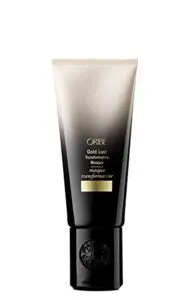
The Oribe Gold Lust Restorative Masque addresses chemical treatment fallout with a vegan formulation that’s backed by real numbers. In a consumer panel of 106 users, 94% reported softer hair after just seven days, while 86% saw visible reversal in hair damage.
The Bio-Restorative Complex—plant collagen, caffeine, biotin, and niacinamide—penetrates deep to rebuild fibers and improve elasticity.
It’s designed for hair masks that don’t just coat damaged hair but actually repair it from within, strengthening weak spots left by bleaching, coloring, or perming.
Best For: Anyone with chemically treated, bleached, or color-damaged hair looking for a high-performance mask that delivers measurable repair and softness within a week.
- Clinically backed results with 94% of users reporting softer hair and 86% seeing visible damage reversal after seven days
- Bio-Restorative Complex with plant collagen, biotin, and niacinamide penetrates deep to rebuild and strengthen from within, not just coat the surface
- Clean, vegan formula that’s free of parabens and sulfates, safe for color-treated hair, and dermatologist-tested for sensitive scalps
- Expensive at $69, which may not fit every budget for regular maintenance
- Requires at least 15-30 minutes of application time for best results, which isn’t ideal for quick routines
- Some quality control issues reported, with products occasionally arriving opened or used
2. amika Hydro Rush Moisture Mask
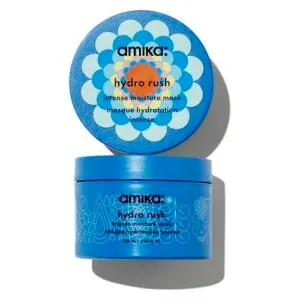
If rebuilding damaged fibers is your goal, the Amika Hydro Rush Intense Moisture Hair Mask brings serious hydration that lasts. Squalane and hyaluronic acid—the Hydro Rush ingredients—lock moisture in for five straight days, making your hair 5x more hydrated and 4x stronger.
Breakage reduction hits 76%, and tangles drop fivefold, which matters when you’re dealing with chemically compromised strands.
User experiences confirm it softens hair and works well on color-treated and textured types, though the $44 cost analysis might give you pause.
For damaged hair needing deep hair hydration and repair, this mask delivers measurable results, not just temporary shine.
Best For: Anyone with chemically damaged, dry, or color-treated hair who wants deep hydration that lasts multiple days and measurable strength improvement.
- Clinically proven results with 76% breakage reduction and hydration lasting 5 days
- Works across multiple hair types including color-treated and textured hair (like 4c)
- Contains powerful ingredients (squalane and hyaluronic acid) that make hair 5x more hydrated and 4x stronger
- Price point at $44 may be steep for regular use
- Results require consistent application to maintain
- Amount of product needed varies by person, potentially making it run out faster
3. K18 Leave In Hair Mask
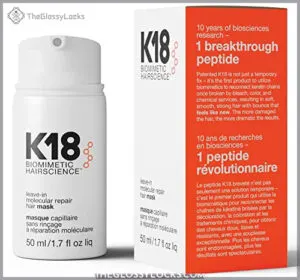
While hydration addresses surface problems, K18 LeaveIn Molecular Repair Hair Mask targets damage reversal at the structural level using peptide technology. Its patented K18Peptide reconnects broken keratin chains, restoring up to 91% of hair’s original strength and 94% of elasticity after bleach or chemical treatments.
User experiences confirm reduced breakage within 2-3 uses, with results that don’t wash away. Application guidelines recommend 1-3 pumps on towel-dried hair, a 4-minute wait, then style—no rinsing needed.
At $75, it’s pricey, but market impact speaks volumes: over 20 billion TikTok views and top U.S. hair care rankings prove this molecular repair approach works on chemically-treated hair.
Best For: Anyone with chemically damaged, bleached, or color-treated hair who wants molecular-level repair instead of just surface conditioning.
- Restores up to 91% of hair strength and 94% of elasticity using patented peptide technology that actually reconnects broken keratin bonds
- Works in just 4 minutes as a leave-in treatment, with results that last through multiple washes instead of rinsing away
- Suitable for all hair types including curly and coily hair, with visible reduction in breakage after just 2-3 uses
- Expensive at $75 per bottle, with some users reporting only 4-6 uses per container
- Contains alcohol which may cause dryness or frizz for certain hair types despite the repair benefits
- Results vary by individual—some users don’t see significant improvements worth the premium price point
4. Virtue Flourish Thinning Hair Mask
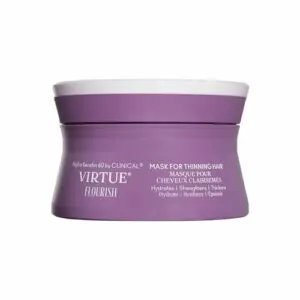
When hair loss combines with chemical damage, you need keratin technology that works without weighing strands down. Virtue Flourish Thinning Hair Mask delivers Alpha Keratin 60ku CLINICAL, a biotech-derived protein that strengthens the scalp’s moisture barrier while Biomimetic Tetrapeptide and Red Clover target follicles for healthier growth.
Clinical efficacy data shows 94% reported instant hydration and 91% felt nourished hair after one use in a 58-subject trial. Consumer feedback confirms improved thickness and shine, though a few noted minimal visible change.
Use it 1–2 times weekly for 2–3 minutes on damp, damaged hair—at $49, it’s strategic hair repair meeting scalp care.
Best For: Those with chemically damaged, thinning hair who want a science-backed treatment that hydrates and supports growth without weighing down fine strands.
- Clinical results show 94% felt instant hydration and 91% noticed healthier hair after one use, with lightweight formulation that doesn’t add weight to thinning hair.
- Alpha Keratin 60ku and tetrapeptide technology target both scalp health and follicle stimulation for dual-action repair and growth support.
- Free from silicones, sulfates, parabens, and synthetic dyes—safe for color-treated hair with natural ingredients like red clover and biotin.
- At $49 (after discount from $59.50), it’s pricier than drugstore masks, requiring consistent weekly use for best results.
- Some users reported minimal visible difference in thickness or increased hair fall, though anecdotal reports don’t match broader clinical findings.
- The 2–3 minute application time adds extra steps to your routine, which can feel inconvenient when you’re short on time.
5. OUAI Fine to Medium Hair Mask
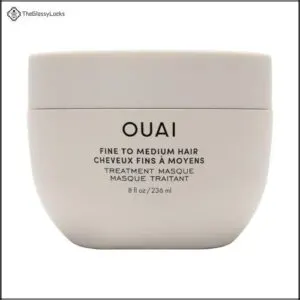
For chemically damaged fine-to-medium strands, the OUAI Fine to Medium Hair Treatment Masque combines hydrolyzed keratin, shea butter, and panthenol in a restorative formula that strengthens without weighing hair down. These OUAI ingredients work synergistically—keratin rebuilds structural bonds, while shea butter and panthenol lock in moisture and smooth cuticles, reducing frizz and split ends.
User experiences consistently highlight improved softness and manageability after one use, though the signature scent profile divides opinion.
At $38, price justification centers on sulfate- and paraben-free formulation suited for color-treated and heat-styled hair. Longevity effects emerge with weekly use, making it a solid hair mask recommendation for repair-focused routines targeting damaged hair.
Best For: People with fine-to-medium hair dealing with chemical damage, heat styling, or color treatments who need intensive repair without heavy residue.
- Keratin, shea butter, and panthenol combo rebuilds bonds while smoothing cuticles and reducing frizz and split ends
- Sulfate- and paraben-free formula works well for color-treated hair without weighing down finer textures
- Noticeable softness and manageability after a single use, with cumulative benefits from weekly application
- $38 price point sits higher than many drugstore alternatives
- Signature scent is polarizing—some users find it too strong or not to their taste
- Results require consistent weekly use to maintain, not a one-and-done solution
6. Amika Soulfood Hair Mask Nourishing
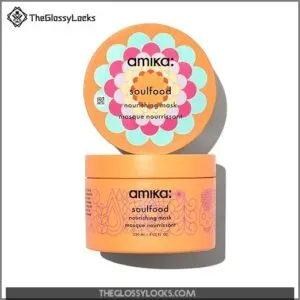
When you’re dealing with hair damage, deep conditioning isn’t optional—it’s essential. The Amika Soulfood Nourishing Mask delivers with jojoba seed oil and sea buckthorn oil, two heavy hitters packed with fatty acids and vitamins A, D, and E that restore lipid barriers in chemically compromised strands.
Clinical moisturization results show hair becomes 11.4 times more hydrated after one use, while 91% of users report manageability improvement.
This vegan formulation addresses dryness and brittleness without silicone buildup, making it a standout choice for hair repair that doesn’t compromise on clean ingredients.
Best For: Anyone with chemically treated, heat-damaged, or severely dry hair who needs intensive moisture and repair without heavy buildup.
- Clinically proven hydration boost (11.4x more moisturized) with noticeable softness and manageability after just one use
- Clean, vegan formula with powerful botanical oils (jojoba and sea buckthorn) that restore lipids and seal split ends
- Versatile use as either a quick weekly treatment or daily conditioner for extremely porous hair
- Strong fragrance may irritate those sensitive to scents or fragrance components like limonene
- Higher price point at $36 may not fit every budget, especially for regular use
- Contains dimethicone and quaternary compounds that raise environmental concerns for eco-conscious users
7. Briogeo Don’t Despair Repair Mask
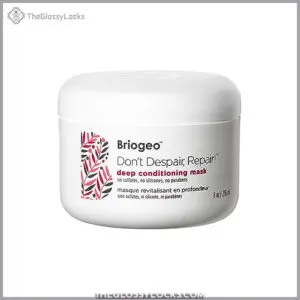
Protein moisture balance isn’t something you can eyeball—your hair needs precise repair ratios, and the Briogeo Don’t Despair Repair Hair Mask nails it. This award-winning formula doubles hair strength after three uses through clinical breakage reduction, proven in controlled brushing tests.
You’re getting deep conditioning treatments powered by rosehip oil, algae extract, and biotin that reconstruct damaged strands in just 10 minutes weekly. The vegan ingredient sourcing keeps it clean—98% naturally derived without sulfates or parabens.
Apply weekly for hair damage repair, then switch to biweekly once you’ve tackled hair breakage and restored resilience.
Best For: Anyone with dry, damaged, or over-processed hair who needs fast, effective repair without spending hours on treatments.
- Doubles hair strength after just three uses with clinically proven results, making it one of the most effective repair masks available.
- Works in only 10 minutes weekly, so you get deep conditioning without a huge time commitment.
- Clean, vegan formula with 98% naturally derived ingredients means no sulfates, parabens, or harsh chemicals—just effective plant-based repair.
- At $39, it’s pricier than drugstore masks, though the award-winning formula and clinical results justify the cost for serious damage.
- Really designed for damaged hair, so if your hair’s already healthy, you might not see dramatic results or need this level of treatment.
- Won’t fix severe split ends or extremely damaged hair on its own—some damage requires a trim alongside treatment.
8. K18 Mini Leave In Mask
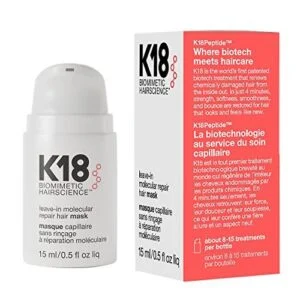
When polypeptide chains snap from bleach or heat, you need molecular repair, not surface conditioning—that’s where K18 Peptide technology separates itself from typical masks. The K18 LeaveIn Molecular Hair Mask reconnects broken bonds in just 4 minutes, delivering measurable improvements in strength and elasticity that last through multiple washes.
Consumer reviews show 78% of users report reduced breakage after using this leave-in treatment on chemically-treated hair. Apply 1–3 pumps weekly depending on your hair damage severity, no rinsing required.
Market impact speaks volumes—20+ billion TikTok views drove this product’s category growth, proving its hair repair credentials through real-world results.
Best For: People with bleach-damaged, color-treated, or heat-styled hair who want molecular-level repair that works fast and lasts through multiple washes.
- Reconnects broken hair bonds in just 4 minutes with patented K18PEPTIDE technology, delivering lasting strength improvements that survive several washes
- Works across all hair types with 78% of users reporting reduced breakage and a 4.7/5 rating across 8,000 reviews
- Leave-in formula requires no rinsing and only 1–3 pumps per weekly treatment, making it simple to use
- Expensive at $29 for 15mL (roughly 4–6 treatments), which concerns 20% of users despite positive results
- Contains alcohol denat as second ingredient, potentially causing dryness with frequent use on certain hair types
- Some users report inconsistent results or product variations depending on where they purchase it
Key Benefits of Using Hair Masks
If your hair’s been through the chemical wringer, hair masks aren’t just a nice-to-have—they’re your fastest route back to healthier strands.
These intensive treatments tackle damage at multiple levels, from rebuilding broken protein structures to sealing in moisture your hair desperately needs.
Let’s break down exactly what hair masks can do for chemically compromised hair and why they outperform your regular conditioner.
Repairing and Strengthening Damaged Hair
When your hair’s been through the chemical wringer—bleach, dye, relaxers, or perms—the damage isn’t just cosmetic; it’s structural, breaking down the protein bonds that give your strands their strength and flexibility. That’s where targeted hair damage repair treatment comes in.
Quality hair masks deliver protein treatments and bond repair technology that literally reconstruct broken disulfide bridges, restoring elasticity improvement and scalp health. These damaged hair solutions focus on cuticle reconstruction, repairing damaged hair from the inside out while strengthening each strand against future breakage.
Deep Hydration and Moisture Restoration
Chemical processing strips away your hair’s natural moisture barrier, leaving strands parched and vulnerable—but the right hydrating ingredients can flood that deficit and lock water back into every fiber.
Intense humectants like hyaluronic acid and glycerin pull water molecules directly into the cortex, while lipid replenishment from nourishing oils restores the protective layer that deep conditioning rebuilt.
Hair masks with emollient benefits deliver cuticle smoothing and scalp hydration, turning brittle, moisture-starved strands into soft, resilient hair through complete hair moisture restoration.
Preventing Split Ends and Breakage
Once moisture is locked in, the real battle begins—because hydrated hair that snaps at the slightest tension is still damaged hair, and preventing those fractures requires a completely different molecular strategy.
Protein-based treatments deliver cuticle protection and elasticity improvement, reinforcing the cortex against heat damage and chemical exposure that cause split ends and hair breakage.
Hair repair masks with keratin or collagen rebuild structural integrity for hair strengthening, while frizz reduction seals those vulnerable ends that would otherwise unravel.
Enhancing Shine and Softness
Strength without shine is like armor that doesn’t gleam—it protects, but it doesn’t look like it’s thriving. That’s where smoothing agents and light-reflecting lipids step in to turn repaired structure into visible, touchable vitality.
Hair masks restore cuticle smoothing and reflective properties through lipid restoration, balancing moisture balance for hair softness and hair shine that signals true hair repair in chemically treated hair.
Protecting Color-treated and Fine Hair
Fine and color-treated hair need formulas that protect without overwhelming fragile strands—because depositing pigment or removing it both leave the cuticle vulnerable to the very ingredients meant to help.
Look for lightweight hydration that won’t collapse volume preservation, gentle formulas with UV protection to slow color fading, and targeted hair repair that fortifies without weight.
Your hair masks should defend what’s left while restoring resilience.
Essential Ingredients for Hair Repair
When chemical treatments strip away your hair’s natural defenses, you need ingredients that actually rebuild what’s been lost. The right combination of proteins, hydrators, oils, and antioxidants can reverse damage at the molecular level and restore your hair’s strength.
Here’s what to look for in a high-quality repair mask.
Protein-based Ingredients (keratin, Collagen)
Think of proteins as the construction crew your hair desperately needs after chemical treatments have torn down its structural integrity—keratin and collagen step onto the scene to rebuild what bleach, dye, and heat have destroyed.
Keratin benefits damaged hair by filling in gaps along the hair shaft, while collagen sources provide amino acids that strengthen your hair structure from within.
Protein absorption happens when these ingredients penetrate the cuticle, literally reconstructing broken bonds for real hair repair.
Hydrating Agents (hyaluronic Acid, Glycerin)
While proteins rebuild the framework, hydrating agents like hyaluronic acid and glycerin swoop in to drench every strand with the moisture chemically damaged hair craves. Their humectant properties pull water into the hair shaft, boosting hydration levels that chemical treatments strip away. In mask formulation, these ingredients create a moisture reservoir that aids deep conditioning and hair repair for chemically-treated hair.
Why hydrating agents matter for hair masks:
- Hyaluronic benefits include holding 1,000x its weight in water—imagine tiny moisture magnets clinging to each strand
- Glycerin sources (plant-derived or synthetic) attract atmospheric humidity directly into parched hair
- Humectant properties prevent moisture loss between washes, maintaining hair hydration over time
- Deep conditioning with these agents softens brittle, damaged cuticles without weighing hair down
- Mask formulation with dual humectants creates synergistic hair repair that protein alone can’t achieve
Nourishing Oils (coconut Oil, Shea Butter, Argan Oil)
After hydration comes the sealing step—nourishing oils like coconut oil, shea butter, and argan oil lock in moisture while coating damaged cuticles with a protective lipid barrier that chemical processes destroy. These lipid-rich ingredients penetrate the hair shaft to repair chemically treated hair from within, delivering oil benefits that regular conditioners can’t match.
| Oil Type | Primary Benefit | Best Application Method |
|---|---|---|
| Coconut Oil | Deep penetration into cortex | Pre-shampoo treatment for hair repair |
| Shea Butter | Cuticle sealing and softening | Mid-shaft to ends on damp hair |
| Argan Oil | Lightweight shine and protection | Leave-in or added to hair masks |
Smart oil combinations in DIY recipes boost repair—try mixing argan oil with shea butter for maximum moisture retention. When shopping, prioritize sourcing ethics to guarantee your mask ingredients support sustainable harvesting practices.
Antioxidants and Plant Extracts (vitamin E, Green Tea, Aloe Vera)
Beyond the structural work of proteins and oils, antioxidants and plant extracts like vitamin E, green tea, and aloe vera act as your hair’s defense team—neutralizing free radicals from UV exposure and pollution while soothing the scalp inflammation that chemical treatments leave behind.
Antioxidant benefits extend to damage prevention, where extract efficacy shows real impact. Vitamin E shields against environmental stress, green tea polyphenols reduce oxidative damage, and aloe vera’s enzymes promote scalp health.
These natural protection agents in hair masks boost overall hair repair while supporting long-term hair care strategies.
How to Apply Hair Masks Effectively
Getting the most out of your hair mask isn’t just about slathering it on and hoping for the best. The way you prep, apply, and time your treatment makes all the difference in how well those reparative ingredients penetrate and work their magic.
Let’s walk through the essential steps to boost absorption and results for your chemically damaged hair.
Prepping Hair for Maximum Absorption
Your hair’s porosity—its ability to absorb and retain moisture—depends entirely on how you prep it before applying a mask, and most people unknowingly sabotage absorption before they even twist open the jar.
Here’s your pre-treatment protocol:
- Clarifying shampoos strip buildup that blocks hair mask ingredients from penetrating the cuticle
- Scalp exfoliation removes dead cells and product residue for better hair cleansing and conditioning
- Towel drying to damp (not dripping) optimizes hair hydration and moisture without diluting active ingredients
- Product layering order matters—never apply leave-ins before your hair treatment application
Correct Application Techniques for Best Results
Most people apply hair masks like conditioner—smearing product from roots to tips in under sixty seconds—but that’s exactly why chemically damaged hair stays damaged.
Start with damp hair, not soaking wet, which dilutes active ingredients and weakens hair mask benefits. Apply from mid-shaft to ends using sectioning for even distribution, avoiding roots completely unless treating your scalp.
Leave the hair treatment application on for the full recommended duration—usually 5-10 minutes—then rinse thoroughly to prevent buildup that blocks future hair mask usage and compromises your entire hair care routine.
Recommended Frequency and Timing
Overdo it, and you’ll waste product; skip too many washes, and you’re leaving damage on the table—timing your mask treatments is where science meets strategy. Your masking schedule depends on damage severity: weekly hair treatments work for mild processing, while severely compromised strands need twice-weekly hair repair sessions. Post-treatment timing matters—wait 48 hours after chemical services before masking to let cuticles stabilize and boost hair mask application benefits.
- Bleached hair craves consistency—missing even one weekly hair treatment lets oxidative damage compound exponentially
- Overnight masks aren’t always better—extended application duration can cause protein overload in fine, porous hair
- Seasonal adjustments protect your investment—winter dryness and summer chlorine demand modified hair treatment frequency
Tips for Different Hair Types and Concerns
One mask formula doesn’t fit all—fine, coily, bleached, and protein-sensitive strands each demand specific approaches to avoid wasting time on treatments that cause more harm than good.
Fine Hair needs lightweight hydrators minus heavy oils, while Color Treated strands require pH-balanced formulas to seal cuticles. Oily Scalp types should focus application mid-shaft down, and Heat Damage responds best to ceramide-rich repair.
Monitor Protein Balance carefully—too much stiffens hair, too little leaves it limp.
Hair Mask Trends and Effectiveness
The hair mask market isn’t just growing—it’s booming, and there’s solid science backing up why these products actually work. From clinical trials showing measurable improvements to innovative technologies that repair hair at the molecular level, the data tells a compelling story.
Here’s what you need to know about current trends and how to pick a mask that’ll genuinely make a difference for your chemically damaged hair.
Market Growth and Consumer Demand
The global hair care products market tells a compelling story—hair masks climbed from $730.60 million in 2024 to a projected $993.83 million by 2030. This growth is partially attributed to the expanding global market for hair masks.
Consumer preferences are driving this 5.30% annual growth, with chemically-treated hair repair dominating demand. Product innovation centers on moisture-retention formulas that address damage from heat styling and chemical treatments, shaping future trends in treating damaged hair.
Clinical Results and Product Efficacy
Behind the market numbers, clinical study findings reveal real hair transformation results. Hair mask reviews consistently show breakage reduction rates of 60% or more in lab settings using protein-infused formulas. You’ll see hydration improvement levels spike within two weeks, with user satisfaction scores reaching 91% for reinforcement.
Color-treated efficacy stands out—masks preserved vibrancy while cutting breakage by at least 40%, proving hair repair and hair restoration aren’t just marketing promises. These masks often penetrate the hair shaft more deeply than regular conditioners.
Advances in Molecular Hair Repair
Scientists are reshaping how we think about hair repair at the DNA level. Recent breakthroughs show that microRNA therapies, CRISPR technology, and protein crosslinking don’t just coat strands—they work inside follicles to reverse chemically-treated hair damage.
Northwestern researchers saw visible regrowth in 10 days using microRNA-205, while enzymatic serine treatments restore broken keratin bonds faster than K18PEPTIDE alone. Here’s what molecular hair repair now targets:
- Gene switches that wake dormant follicles back up
- Disulfide bond formation deep within damaged fibers
- DHT sensitivity genes linked to thinning and loss
- Stem cell activation for long-term follicle health
- Small molecules that block immune attacks on hair
FDA-approved drugs and stem cell exosomes are moving from labs into real-world treatments, proving molecular strategies can outpace traditional masks.
Choosing The Right Mask for Your Hair Needs
With all these molecular breakthroughs and scientific formulas flying around, how do you actually pick a mask that works for your specific damage situation? Start with hair porosity—high porosity needs heavier proteins, low porosity craves lightweight hydration.
Check scalp health and ingredient sensitivity before chasing trends. Match desired results to proven hair mask ingredients and benefits, weigh budget considerations, then test recommendations suited to your hair types and concerns.
Frequently Asked Questions (FAQs)
Can hair masks reverse permanent chemical damage?
Permanently altered bonds can’t be fully undone—think of it like trying to unscramble an egg.
Permanently altered bonds can’t be fully undone—think of it like trying to unscramble an egg
Hair masks excel at cosmetic improvements and surface-level repair, but realistic expectations matter. They prevent further damage while making chemically-treated hair look healthier through intense conditioning.
How long should I wait after treatments?
After chemical services like coloring or relaxing, wait 48 to 72 hours before applying a hair treatment mask.
This allows the hair cuticle to seal and prevents product interactions that might compromise your color protection or damage assessment efforts.
Are DIY hair masks effective for damage?
Sure, your kitchen probably holds some helpful ingredients—coconut oil, honey, avocado—but DIY hair masks rarely match the precision of lab-formulated treatments for severe hair damage and split ends repair.
Can over-masking cause additional hair problems?
Yes, overuse leads to protein overload, scalp buildup, and product saturation—all of which compromise hair elasticity.
Damaged strands become stiff, prone to breakage, and struggle to absorb moisture properly, worsening hair health rather than restoring it.
Whats the difference between masks and conditioners?
Conditioners coat the hair shaft and work in minutes, while hair masks penetrate deeper with higher ingredient concentration, targeting specific concerns like chemical damage.
Masks require longer application time for meaningful long-term effects on hair structure and health.
Conclusion
Damaged strands demand dedication—and the right hair mask for chemically damaged hair delivers real reconstruction, not just surface smoothness.
Your hair’s internal structure needs protein, moisture, and lipid replenishment to reverse what bleach and dye stripped away. These eight masks target broken bonds at the cortex level, giving you back elasticity, shine, and resilience.
Choose based on your specific damage profile, apply consistently, and watch compromised hair transform into something that actually holds its shape again.
- https://pmc.ncbi.nlm.nih.gov/articles/PMC6218806/
- https://www.sciencedirect.com/science/article/pii/S0365059621003147
- https://onlinelibrary.wiley.com/doi/abs/10.1111/jocd.14148
- https://us.typology.com/library/what-are-hair-masks-formulated-from
- https://www.linkedin.com/pulse/hair-mask-market-innovation-outlook-2030f-retail-research-trends-jfmtc

